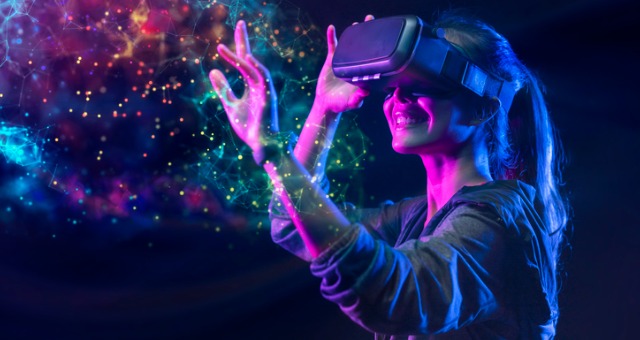In today’s modern, technology-driven world, faculty are often seeking ways to deliver a more engaging and effective learning experience. Augmented reality (AR) is a powerful tool offering a variety of benefits to university teaching. From providing a lifelike virtual environment to helping students visualize complex scientific concepts, AR can revolutionize the way faculty teach (López-Belmonte et al., 2020).
AR technology was first introduced in the 1960s by Ivan Sutherland, who developed the first ever “Head Mounted Display.” This system allowed users to interact with a virtual environment projected on a display. Modern AR is a technology that superimposes digital information onto the physical world. It is a computer-generated overlay of digital information and visuals in the physical environment. This technology allows users to view virtual objects in the real world through their mobile device’s camera, such as a tablet or smartphone. AR is free or low-cost, and AR applications work with a variety of devices, from laptops to mobile phones. Faculty can create interactive and immersive scenarios, often that are difficult to replicate in physical classrooms, with minimal setup.
Some faculty may be intimidated by a new technology like AR. We hope to ease those concerns by presenting brief examples of using AR to teach across a variety of disciplines.
History
Faculty can use AR in a history class to help students better visualize and interact with historic sites. For example, a history professor might create virtual replicas of ancient ruins, allowing students to explore the detailed layout of the sites. This can be especially beneficial for students who may not have access to physical field trips. In addition, faculty can show interactive visualizations of timelines or key events in history, making it easier for students to understand the context and implications of different periods of time. AR can help faculty breathe new life into the study of the past.
Chemistry
Students can use AR to immerse themselves in the material. For example, they can interact with virtual models of molecules and visualize the structure and properties of compounds. This can help them understand the relationships between elements and learn how to use instruments in a virtual lab setting. Instead of being confined to pencil and paper in order to understand chemical equations, students can actually visualize these interactions. AR can also simulate chemical reactions, allowing students to gain an in-depth understanding of the different processes involved, without having to use costly and potentially dangerous materials.
Anatomy
Students can access detailed three-dimensional models of the body and explore the organs and systems from different angles. This can help deepen their understanding of the complex relationships between different parts of the body and the larger systems that connect them. Faculty can create interactive simulations of how smoking, diseases, and other negative (or positive) circumstances affect organs and body functions, going beyond what’s possible with just observing a human patient.

Dance
Dance faculty can create interactive choreographies and tutorials, allowing students to explore the movements and postures of different styles of dance. Students can create virtual worlds to practice and experiment with different routines and techniques. This can be especially beneficial for students who would otherwise have difficulty learning certain moves because of physical limitations or lack of access to a real-life instructor.
Business
In our business classes, we’ve used AR for interactive data visualizations. Students could better understand complex datasets such as population trends or economic indicators. By visualizing the data in an immersive environment, students could identify patterns and make connections between data points, something that they often struggle with when simply examining spreadsheets and datasets. Beyond the classroom, we’ve also experimented with having students create AR business cards for their resumes and LinkedIn profiles, which were quite a unique conversation starter!
Looking ahead
Faculty should be aware of equity issues with adopting AR (Garzón et al., 2019). For example, visually impaired students may find it difficult to interpret the visuals. The technology may not be available for all students, particularly those in remote areas or who do not have reliable internet access or connected devices such as smartphones or tablets. Faculty must also plan and monitor pedagogy so that students do not focus only on the novelty of AR and lose sight of the material and learning objectives (Garzón et al., 2020).
There are myriad applications for AR education, and likely one specific to your field or discipline. For a general introduction to AR and some pre-built resources, take a look at Assemblr Edu. For faculty looking to design their own AR experiences, Adobe Aero is a new tool targeted toward easy AR content creation.
We know students are familiar with trending technology. In our quest as teaching professors to refresh our content and modernize our delivery, augmented reality is one tool we can have in our toolkit to better reach students and redefine what it means for them to engage with the content.
Rich Yueh, PhD, is an assistant professor of teaching in information systems, and Jonathan Lim, PhD, is an assistant professor of teaching in marketing in the School of Business at the University of California, Riverside.
References:
Garzón, J., Baldiris, S., Gutiérrez, J., & Pavón, J. (2020). How do pedagogical approaches affect the impact of augmented reality on education? A meta-analysis and research synthesis. Educational Research Review, 31, 100334.
Garzón, J., Pavón, J., & Baldiris, S. (2019). Systematic review and meta-analysis of augmented reality in educational settings. Virtual Reality, 23(4), 447-459.
López-Belmonte, J., Moreno-Guerrero, A. J., López-Núñez, J. A., & Hinojo-Lucena, F. J. (2020). Augmented reality in education. A scientific mapping in Web of Science. Interactive learning environments, 1-15.



